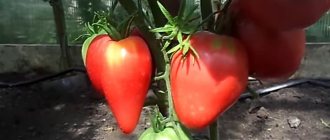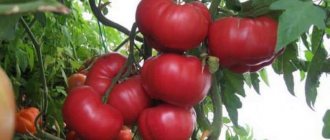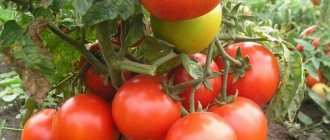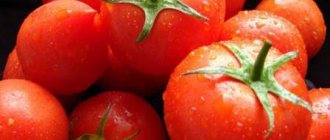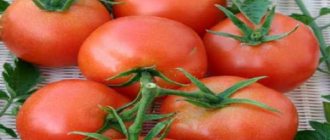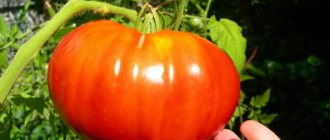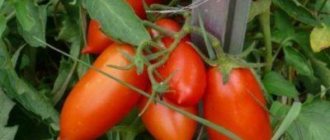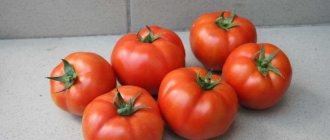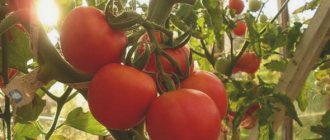Tomato “Finish” varietal selection of the Volgograd experimental station VNIIR named after. N.I. Vavilova. Created specifically for open ground cultivation. “Finish” tomatoes are resistant to weather stress, unpretentious and consistently productive, and have earned only good reviews.
Description of the variety: “Finish” is a late, medium-fruited variety. Gives the first harvest 120-130 days after germination. The bush of this variety is semi-determinate, reaching 60-75 cm. The stem is powerful and well developed. The leaves on the bushes are of normal shape, light, slightly corrugated. The bush gives 3-4 stepsons from below. Does not require pinching. Tying the bushes "Finish" is preferable, but not necessary. The yield of this variety is good: 7-7.5 kg per 1 sq. m.
Characteristics of the fruit: The fruits of ripe Finish tomatoes are red, however, not bright, but have an orange tint. Fruit weight is about 80-100 grams. Fruits with excellent taste and technical qualities. The tomato pulp is juicy and contains a small number of seeds. These tomatoes are perfect for fresh consumption, as well as for processing, including whole-fruit canning and pickling. After heat treatment, the amount of vitamins in tomatoes almost doubles!
Reviews on the transportability and keeping quality of the variety are also positive.
Description of tomato
This tomato was bred by breeders working at the Volgograd Experimental Station VNIIR named after. N.I. Vavilova.
Tomato Seeds Finish
The variety is classified as a determinant type, so its height can reach no more than 0.75 m.
Tomato Finish – medium ripening period. Moreover, from the moment of seed germination to the harvesting of ripe tomatoes, a little more than 4 months pass.
Related article:
Tomato Absinthe - description and characteristics of the variety with green fruits
The shoots of the bushes of this variety are erect, strong and strong, and practically do not bend under the weight of ripening fruits. Therefore, although it is advisable to tie the stems to supports, this is not necessary.
The stems are well leafy, the foliage is of medium size, typical tomato shape, narrow, with sharp tips, slightly wrinkled. The color of the leaf blades is deep emerald.
Stepchildren usually form at the bottom of the bushes, but their removal is usually not required.
Tomato Finish
The first inflorescence is formed under 6 permanent leaves, and each subsequent one is formed through a pair of true leaves, and the distance between the inflorescences is about 12-16 cm.
Small yellow flowers are collected in racemes, with up to 5-7 ovaries formed in each of them.
Ripe tomatoes of this variety are oval, less often round. The fruits are even, smooth, red in color with an orange tint, their average weight is approximately 90-100 g.
Related article:
Abakan pink tomato - description and characteristics of a mid-early variety
The skin of the fruit is slightly compacted and not prone to cracking. The pulp is tender, inside there are up to 6 seed chambers with an average amount of seed material.
Tomato Finish
The taste of ripe tomatoes is pleasant - sweetish with a slight sourness. The harvested crop can be transported to any distance, while the taste and appearance of ripe tomatoes do not deteriorate. Also, the fruits of this variety can be stored for quite a long time in appropriate conditions.
Finish – Tomato plant variety
Variety characteristics:
Properties of the Finish variety:
Recommended region on the map:
Information about the admission of Tomato Finish from the Register of the State Variety Commission of the Russian Federation
Application for admission No. 27924, registered 1994-04-25. The Tomato Finish variety was included in the register of approved varieties in 1997. Approved for use in the regions: North Caucasus, Lower Volga.
The originators of the Tomato Finish variety are:
Other varieties of tomato plant
Search for variety by name
Variety selection
Question to the portal experts
If you haven't found the answer to a question, don't hesitate to ask an expert.
Have you already planted Tomato Finish?
Tell us if you liked this variety? Will you plant it again?
Main characteristics
Finish tomato bushes are highly resistant to sudden changes in weather conditions and can easily tolerate sudden drops in temperature, periods of rain and short-term drought.
Productivity
The yield of this variety is quite high; up to 8 kg of ripe fruits are collected from each square. And when growing Finish tomatoes on an industrial scale, up to 300-600 centners of ripe products are collected from each hectare of area.
Tomato yield Finish
Area of application of fruits
The collected fruits have a good taste, so they are primarily used for fresh eating and added to summer salads. They can also be used in preparing various snacks. Tomatoes are also used for preservation, and during heat treatment the tomatoes do not burst, and the amount of nutrients in their composition does not decrease. And housewives note that the most delicious of the fruits of this variety is tomato juice.
Related article:
Mistakes in growing tomatoes
Tomatoes Chio Chio San on video
Producer of seeds of this variety: agricultural company Gavrish.
If you grew Cio-Cio-San tomatoes, please write whether you liked them or not. What was the yield and taste of the fruits in your climatic conditions? Will you grow them again? How do you rate the disease resistance of this tomato? Briefly describe the advantages and disadvantages of this tomato in your opinion. If possible, attach a photo of the entire bush or individual fruits you grew to your comment. Thank you!
For other interesting varieties with photos, descriptions and reviews, see our Tomato Catalog alphabetically. Enjoy watching!
Your reviews of the Chio Chio San tomato and additions to the description will help many gardeners evaluate this variety more objectively and decide whether it is worth planting or not.
This is a natural variety of tomato. Therefore, we recommend taking seeds from a ripe fruit and using them for planting in the following seasons. A website about tomatoes is always at your service - Tomatland
Diseases and pests
It is noted that this tomato has increased resistance to Vertecillium wilt. But it can still be affected by some other diseases:
- Late blight . At the same time, characteristic brown spots appear on the foliage, shoots and ripening tomatoes. And a powdery coating simultaneously appears on the bottom of the leaf blades.
- Fomoz . In this case, large spots of brown color appear near the stalks. Affected fruits cannot be used for food; moreover, they are a source of infection for healthy tomatoes. Therefore, at the first signs of infection, fruits should be removed and destroyed.
- Cladosporiosis . The first symptom of this disease is the appearance of light gray spots on the leaf blades. The disease quickly spreads throughout the plant, resulting in its death.
- Apex rot . At the same time, wet spots appear on the tops of the fruit. Such fruits begin to ripen ahead of time, but do not have a marketable appearance, and their taste also deteriorates. First of all, this disease affects those fruits that come into contact with the fetus.
- Stick . This viral disease is characterized by the appearance of yellow stripes on the vegetative parts of tomato bushes. As a result, the flowers begin to fall off and the fruits do not set.
Important to know: The best remedy for late blight on tomatoes
For the treatment and prevention of fungal diseases, the following drugs should be used:
- HOM;
- Oksikhom;
- Speed
Related article:
Proper watering, fertilizing and caring for tomatoes
The bushes of this tomato should be treated with fungicide solutions at intervals of 12-14 days. If the tomatoes are affected by viral diseases, then they need to be removed and burned outside the site, and the soil should be treated with a solution of copper sulfate or Bordeaux mixture.
Finish tomato bushes can most often be attacked by:
- Colorado potato beetles;
- whiteflies;
- slugs
To get rid of adults and larvae of the Colorado potato beetle and whiteflies, tomatoes of this variety should be sprayed with a solution of the drug Fitoverm . And slugs are usually picked from the bushes by hand, and the soil around the plants is sprinkled with wood ash mixed with tobacco dust and lime.
The most popular varieties
Over the past years, these varieties of tomatoes for open ground have taken leading positions in cultivation in our climate. All of them are quite unpretentious and have good taste and product characteristics.
Mystery
Gardeners in our climate zone prefer the Riddle tomato variety for planting in open ground. It has low bushes with a small amount of foliage and 5–6 tomatoes per cluster.
The size of Riddle tomatoes is not very large, and their weight is unlikely to exceed 85 grams. The riddle has pretty good taste characteristics. Ascorbic acid, which is contained in the pulp of Riddle tomatoes, gives them a slight sourness. They are suitable for both home cooking and for twisting.
The resistance of these plants to root rot and late blight makes them ideal for growing in open beds. The productivity of Riddle will be about 3 - 4 kg per square meter.
North F1
Sever F1 bushes in open beds can grow up to 70 cm in height, and the first tomatoes will begin to ripen on the 85th day. Moreover, each brush can hold up to 6 fruits.
Round tomatoes Sever F1 are uniformly colored reddish. The weight of a ripe tomato can be either 120 or 130 grams. They are quite meaty in their density, so they will be an excellent ingredient for salads. But despite this density, Sever F1 tomatoes withstand transportation and storage very well.
North F1 will not be afraid of tobacco mosaic, anthracnose and alternaria. In addition, this variety grows well both in open ground and in a greenhouse. But it is worth considering that the yield of plants outdoors will be less than in greenhouses.
Main pros and cons
The main advantages of the Finish tomato include:
- good yield;
- beautiful appearance of ripe tomatoes;
- great taste;
- the harvested crop can easily withstand transportation over any distance;
- tomatoes have good keeping quality;
- high resistance to verticulous wilt;
- the ability to collect seed material for subsequent planting.
Related article:
The best varieties of black tomatoes
Among the disadvantages, the low resistance of the variety to a number of fungal and viral diseases should be noted.
Advantages and disadvantages
Compared to other varieties, Debut tomatoes have the following advantages:
- Early ripening;
- High resistance to a number of diseases;
- High yield;
- Good transportability of fruits;
- Compact size of the bush;
The main disadvantage of this variety is the mandatory tying of plants so that the ripening large fruits do not touch the soil surface.
Important! Some people think that the Debutante and Debut tomato are the same variety. Actually it's not like that
Debutante is a separate variety, differing from its consonant Debutante in appearance and characteristics.
Thus, Debut is a variety with high yield potential. You can implement it by following all the recommendations for growing it.
vote
Article Rating
Planting seed material for seedlings
This tomato variety should be grown in seedlings. In this case, planting of seed material should be carried out approximately 50-55 days before the intended transplantation of plants to a permanent place in the garden beds. In the southern regions, this procedure is carried out in the last ten days of February - the second ten days of March, in the middle zone the planting date is shifted to the second ten days of March, and in the northern regions, seeds are planted in the first ten days of April.
If you plan to grow this tomato variety in greenhouse conditions, then seedlings can be grown 12-14 days earlier. Purchased seed material does not require additional processing if it has a multi-colored shell. If it is absent, then the seed material should be treated against diseases before sowing.
Related article:
Prohibition" for tomatoes (Kazarin method)
To do this, you need to soak the seeds in a weak solution of potassium permanganate for an hour, then rinse. Or you can prepare a weak soda solution in which the seed material is soaked for 24 hours.
It is better to purchase the nutrient substrate in a specialized store, then it will not have to be further processed before planting.
Planting seed material is carried out in a standard way - seed material is laid out on the surface of the soil, covered with a thin layer of soil about 1 cm thick, and watered. Then the containers are covered with polyethylene and placed in a warm place for germination. After the sprouts appear, the film is removed and the containers are transferred to the windowsill.
After a pair of permanent leaves appear on the plants, you need to pick them in separate cups. A couple of months after the emergence of seedlings, the seedlings can be transplanted to a permanent location.
Related article:
Saving tomatoes from the heat in the greenhouse
How to grow a Finish tomato correctly?
- View the full image
Tomato Finish
Description and advantages of the variety
Preparation of planting material
How to sow seeds for seedlings correctly?
Picking up seedlings
Planting seedlings in the ground
Diseases and pests
Finish tomato fruits have an excellent taste. Tomatoes are eaten fresh or processed. The juice made from them is especially tasty.
Description and advantages of the variety
Tomato Finish is a low-growing (determinant) variety. The height of the bush reaches 60-75 cm. The number of shoots and leaves is small. The fruits are round or slightly flattened, orange-red. The size is average, the weight of one is about 80 g. The seeds are located in 4-6 chambers.
Designed for cultivation in open ground and in film greenhouses.
Fruits begin to form after the 5th leaf, subsequent ones - every 2 leaves. The ripening period is late. It takes 120 days from germination to the harvesting of the first fruits. The advantage of the variety is considered to be stable yield (from 260 to 610 c/ha) and resistance to Verticillium wilt of tomatoes.
Preparation of planting material
Seeds are sown for seedlings a month before planting. If you do this too early, the seedlings will overgrow and stretch, which will negatively affect the quality of the harvest. In southern latitudes this is the end of February - mid-March, in central latitudes - the second half of March. When grown in northern regions, seeds are sown in the first half of April. When growing Finish tomatoes in a greenhouse, you can sow the seeds 2 weeks earlier.
The seeds are being prepared. The multi-colored shell will indicate that they have been processed by the manufacturer. If it is not there, you need to take care of protecting the seeds from diseases yourself. Disinfection is carried out in one of the following ways:
- The seeds are soaked in a weak solution of potassium permanganate for 15 minutes and washed. If kept for a long time, the yield will decrease.
- Soak the seeds for a day in a weak soda solution. It disinfects and accelerates fruiting.
- The aloe leaf is hidden in the cold for a week. Squeeze out the juice and immerse the seeds in it for a day. The treatment increases plant immunity and improves the quality of fruits.
Disinfect the soil in one of the following ways:
- Microwave in small batches for 2 minutes.
- Heat in the oven for 10 minutes at 180°C.
- Spill boiling water.
After disinfection, the soil is watered and kept in a warm room for up to 10 days, until beneficial microorganisms begin to develop in it. Then you can sow the seeds.
How to sow seeds for seedlings correctly?
Place the soil in boxes and lightly compact them. Make grooves 1 cm deep and a distance between them of up to 4 cm. Place the seeds along the grooves at a distance of at least 1 cm. Sprinkle with soil. You can immediately spread the seeds over the surface of the soil, then sprinkle them with a layer of soil. But during the period of emergence, this layer will rise along with the tomato sprouts, creating an air cushion inside. This can harm the seedlings.
Cover with glass or film and install in a room with a temperature of 25°C.
Can be leaned against a heating radiator. This way the seeds will germinate quickly and amicably. Control soil moisture by opening the glass and shaking off any dew drops on it. If the soil dries out, moisten it with a spray bottle. The appearance of mold indicates that watering was excessive and humidity was high.
Remove the affected layer of soil, spill it with a solution of potassium permanganate or Fitosporin, add new soil. At high temperatures in the room, seedlings appear a few days after sowing, at lower temperatures - later.
Sprouts need to create the following conditions:
- Seedlings need a lot of light. Place the boxes on south or southwest windows. If the lighting in the room is weak, illuminate them with phytolamps.
- The humidity in the room should be high. To do this, you need to spray the seedlings daily with water at room temperature and install air humidifiers.
- The temperature during the day should not fall below 18, and at night 12°C. The optimal temperature for the day will be 22°C.
Remove the film or glass. Watering is carried out as the soil dries. It should not be overdried so that the seedlings do not die. But you can’t overfill it, it can be destroyed by the fungal disease blackleg. It is especially dangerous for seedlings that are installed on a cold windowsill and grow in damp soil.
I water the young shoots, avoiding the cotyledons and true leaves. It is convenient to do this with a syringe. Hardening off seedlings begins as early as possible. Start with 5 minutes and gradually increase the procedure time. Be careful with the wind, which can dry out the leaves, turning them white. Hardened seedlings are distinguished by a purple hue of leaves and a strong, hairy stem. She is not afraid of direct sunlight and wind.
Picking up tomato seedlings
Before diving, liquid organic matter or mineral fertilizers are added, the dosage of which is reduced by 2 times. Planting of seedlings is carried out after true leaves appear. This is done after the seedlings become crowded in the box.
How to pick seedlings correctly:
- Pots are being prepared. Their volume depends on the size of the seedlings. Fill them with soil.
- The seedlings are pre-watered so that the root system is damaged as little as possible during transplantation.
- Use your left hand to hold the plant by the stem. Using a dull knife or spatula, pry up the soil so that the root comes out along with a lump of earth.
The pick is performed once or twice. It allows you to increase the power supply area. When transplanting, the roots are broken off, which leads to the formation of a large number of new ones, and the root system is strengthened.
Planting seedlings in the ground
Seedlings are planted in open ground after the threat of return frosts has passed. Usually this is the end of May, the beginning or first ten days of June. Choose a sunny, well-ventilated area; growing in light partial shade is allowed. The best predecessors for tomatoes are carrots, onions and cucumbers. Strawberries in the neighborhood improve the quality of the fruit. Do not plant tomatoes after potatoes, peppers and eggplants.
If the acidity is high, slaked lime is added, and if the acidity is low, sulfur is added. Apply 0.5 kg per 1 m2. The area for growing tomatoes is being prepared in the fall. After harvesting the predecessor crop, the remains of the tops are removed, chicken manure, peat, humus, compost are added at the rate of 5 kg per 1 m2 or mineral fertilizers (25 g of potassium salt, 50 g of superphosphate). Dig to a depth of 25 cm.
In the spring, fertilize a second time, but avoid getting fresh manure. It will lead to vigorous growth of stems and leaves, and weaken the growth of fruits. It is better to use humus. In the southern regions, Finish tomatoes are planted in rows at a distance of 50 cm. If tomatoes in the garden are often affected by late blight or other fungal diseases, increase the distance between plants to 70 cm.
If groundwater comes close to the surface of the site, Finish tomatoes are planted in ridges. They are formed in the direction from north to south. The width of the beds is 120 cm, the height is 15 cm. Tomatoes are planted in 2 rows.
Tomatoes can be planted:
- Square-cluster method (distance between bushes is 70 cm, up to 3 plants are planted in one hole.
- Using the strip-nesting method (irrigation furrows at a distance of 1.4 m, tomatoes are planted on both sides, at a distance of 60 cm from them). 2 bushes are installed in one hole.
The feeding area of each bush is 0.3 m2. To plant a 100 m2 plot, you need about 250 plants. It is better to plant tomatoes in the evening. If planted in the morning in sunny weather, they will also survive, but will wither a little at first. Water the plants abundantly in advance so that the soil adheres well to the roots. Dig holes 15 cm deep. Water using 1 bucket of water per 8 holes. If the previously applied fertilizers are not enough, mineral or organic fertilizers are added to the water.
Remove the seedlings from the container, carefully turning the container on its side. Place it in the hole so that the root system is completely immersed in it. Cover the holes with earth. Mulch with mowed grass and sawdust 10 cm high.
You can avoid watering for about a week. After 10 days, the seedlings are inspected, a new one is planted in place of the missing one, and watered. If deemed necessary, tie up the plants. This is not necessary for determinate varieties, but a tied bush will receive more light and be less affected by diseases. Subsequently, the soil is loosened between the rows and weeds are removed. Once the fruits have set, the leaf underneath can be removed. Stepchildren break off if they interfere with the normal development of the bush. Several stepsons can be left for fruiting.
Transplanting seedlings into open ground
The place for planting tomatoes should be well lit by sunlight. But it is also possible to grow tomatoes in light partial shade. When choosing a site, you must not forget about the rules of crop rotation. The best predecessors for tomatoes are carrots, onions or cucumbers. The best neighbor for a tomato is strawberry. And after potatoes, peppers and eggplants, tomatoes are not planted according to the rules of crop rotation.
The soil on the site is prepared in advance - lime is added to too acidic soil, humus or compost is added to depleted soil, as well as potassium salt and superphosphate.
In the south of Russia, this tomato is planted in rows, and the distance between neighboring plants should be 0.5 m. And the row spacing should be about 0.7 m.
Related article:
Tomato Sugar brown - description, characteristics and reviews
The best early ripening varieties
These varieties and hybrids of tomatoes for open ground will be the first to ripen. As a rule, their ripening period will not exceed 90 days.
Daria
Daria tomato plants do not stand out much for their size. When grown in open beds, their height will not exceed 110 cm. One fruit cluster of this variety can grow from 5 to 6 tomatoes, which ripen in 85–88 days.
The weight of Daria tomatoes in most cases will be between 120 and 150 grams, but larger specimens are also found. At maturity they turn a rich, bright red color. Round Daria tomatoes have very tasty pulp, which is used with equal success both for cooking and for canning.
Daria's immunity is able to resist diseases such as fusarium, tobacco mosaic and alternaria. If the growing conditions are met, the yield per square meter can reach 17 kg.
Abundant F1
Abundant F1 is a hybrid variety. The height of its determinate plants with small dark green leaves will only reach 100 cm in height. When grown in open beds, the first Izobilny F1 tomatoes will ripen in 85 days.
Important! It is advisable to tie the Abundant F1 hybrid to a support.
In addition, to increase its yield, the gardener will have to occasionally prun the bushes.
Round-flat tomatoes of this hybrid will not grow weighing more than 70 - 90 grams. Having reached the ripening period, they are uniformly colored deep pink or red. The average density of the pulp and good taste allow the tomatoes of the Izobilny F1 hybrid to be used with equal success both for salads and for canning.
Like other hybrid varieties Izobilny F1 has increased resistance to many diseases, especially fusarium and tobacco mosaic. Its bushes set up very well and produce a harvest. From each of them the gardener will harvest up to 2.5 kg of crop, and from a square meter of planting area up to 7 kg.
Further care
Tomatoes Finish in the greenhouse
After the seedlings are transplanted into garden beds or greenhouses, further care of the plants consists of the following activities:
- irrigation regime;
- application of fertilizers;
- loosening and weeding;
- timely harvest.
Water the bushes of this tomato 2-3 times a week throughout the growing season. During the rainy season, you can reduce the number of waterings, and in dry, hot weather - increase. Approximately 10-12 days before harvesting, stop watering the tomatoes.
After watering or rain, the crust that forms on the soil surface must be removed. To do this, the root zone needs to be loosened, while simultaneously removing all the weeds along with the roots.
It is not necessary to tie up the bushes of this tomato, since the shoots are not too tall, but after tying the plants receive more light, the fruits do not come into contact with the soil and are not affected by diseases. Stepchildren should be removed only if they interfere with plant development. It is recommended to remove foliage above ripening fruits.
Related article:
Proper watering, fertilizing and caring for tomatoes
Growing and caring for the variety
Varietal characteristics, their characteristics and descriptions form a number of rules, without which it is difficult to obtain a decent harvest.
We grow seedlings
The quality of seedlings grown in compliance with the regime of day and night temperatures, lighting, dosed watering and fertilizing will become a reliable guarantee of a good harvest.
- Seeds begin to be planted for seedlings 60-65 days before the planned planting in the greenhouse. This is mainly the month of March. The date largely depends on the climatic conditions of the region and the quality of the greenhouse shelter.
- Seeds are prepared by disinfection in a manganese solution and treatment with a growth stimulant.
- Planted in moist soil, deepened by 2 cm. Germination should be expected after 5 days.
- Plants pick up when the first true leaf appears, planting them in separate containers.
- Seedlings require moderate watering and fertilizing. At the initial stage, especially in cloudy weather, lighting is required to prevent the stems from stretching.
For those who have planted tomatoes more than once, these rules will not seem too complicated. But they shouldn’t be ignored either. By observing the day and night regimes and moistening the soil in time, you can get high-quality healthy seedlings, ready for any load.
A feature of indeterminate varieties is intensive, almost unlimited growth.
It is necessary to pay attention to the correct formation of the bush: removal of side shoots, excess foliage and timely limitation of stem growth
Replanting the tomato to a permanent location
There are no special secrets in the agricultural technology of growing the Moscow Delicacy tomato variety.
- Seedlings are planted in the greenhouse in May. The recommended layout is 70 x 50 cm, which is approximately 3-4 plants per square meter.
- We grow tomatoes by tying them to trellises or vertical supports.
- As it grows from the bottom of the stem to a height of 60-80 cm, the leaves are removed. This measure improves air exchange, prevents the spread of fungal diseases, and does not distract the plant’s strength from the main task - the formation of ovaries.
- The bush is formed into 2-3 stems, leaving 4 to 7 ovaries on each. After the required number of brushes is formed, the crown of the plant is pinched.
- Water the bushes with warm water, at the root. It is especially necessary to monitor the soil moisture at the time of flowering and intensive growth of tomatoes.
- Care comes down to watering, loosening the soil, fertilizing, removing stepsons and yellowed foliage.
- The harvest begins in July and August.
- With the onset of cold weather, they monitor the plants, trying to identify possible diseases in time. The variety can be affected by nematodes and late blight.
The presented description of agrotechnical techniques allows you to understand the main stages of plant care. Of course, every gardener has his own secrets for getting a good harvest. Someone thinks that if I planted tomatoes in a greenhouse, then I should use its entire volume. Let them grow to the very top. This practice is suitable for this variety.
Even on the street, “Moscow Delicacy” forms ovaries well, especially in hot weather. What can we say about greenhouse conditions? But tomatoes must have time to grow at least to a state of technical maturity. This must be taken into account in short summer conditions. Otherwise the variety is very productive. Housewives are happy with it and enjoy using it in home cooking.
Advantages and disadvantages
Using the first generation F1 tomato hybrid has the following advantages:
- high productivity;
- increase in precocity;
- equal height of plants;
- fruits of the same size within the same inflorescence;
- evened color of tomatoes;
- high quality fruits, including a high content of the antioxidant lycopene, sugars and solids, vitamin C;
- higher plant resistance to diseases and pests, such as root-knot nematode, fusarium, cladosporiosis.
- adaptability to changing environmental conditions, frost resistance.
Tomato Monsieur f1 description is similar in early ripeness, bush and fruit shape to the Family tomato. The only drawback of hybrid tomatoes is that they are not germinated with seeds from their own fruits. The peculiarity is that they can only be purchased in branded packaging. Attempts to plant second-generation hybrid seeds will lead to the loss of all the best qualities of the tomato and the overall unpredictability of the result. After all, the seeds of the hybrid were obtained through the complex work of professional breeders.
